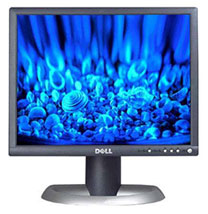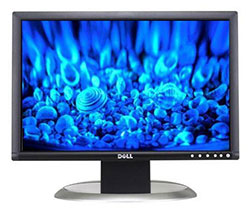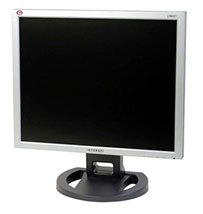Buyer's Guide: Mid-Range to High-End, May 2005
by Jarred Walton on May 23, 2005 5:30 PM EST- Posted in
- Guides
Display Recommendations
Before we get to the actual display recommendations, we have to say that the end of the CRT era is upon us. No matter how much you like your 21" CRT running at 2048x1536 resolution with a high refresh rate, there's a very good chance that the next major display upgrade that you make will be to an LCD. Why? It's simply a matter of reduced profit margins. In fact, looking at the current CRT landscape, we can see that specifications have fallen off quite a bit in the past few years.We used to look at 19" models that could run 1600x1200 at 85 Hz or higher, and quality 17" models frequently supported 1600x1200 at 75 Hz. Today, the best new 17" models support 1280x1024 at 67 Hz (which means that you'll run them at 60 Hz or else drop down to 1152x864 to get 75 Hz). 19" models still support 1600x1200 and sometimes higher resolutions, but only at 75 Hz or lower refresh rates. Even the 21" models have diminished in quality. The Mitsubishi Diamond Pro 2070 had a 140 kHz horizontal scan rate, allowing for 2048x1536 at 85 Hz or 1600x1200 at 115 Hz.
Unless you want to buy a refurbished display, you'll have difficulty finding a monitor that can beat those specs now. The NEC FE2111SB has a 115 kHz horizontal scan rate, limiting it to 85 Hz at 1600x1200 or 75 Hz at its maximum 1920x1440 resolution. Competing models are similar in specifications if not worse. In short, though the top CRTs still offer reasonable performance for the price, they're a dying breed. If you love CRTs - particularly the large models - we'd suggest that you try to find a Diamond Pro 2070 or NEC FP2141SB (the NEC model seems to be quite a bit more expensive, but specifications are nearly identical to the 2070). We've found the 2070 for around $650, but quantities are limited and you may not be purchasing a new display.
Unless we see a new CRT that actually boasts better specs than the older models, we're going to move on to recommending LCDs for the Mid-Range and High-End price segments. Prices have dropped to the point where most people will prefer an LCD to a CRT anyway. The displays have a perfectly flat surface and there are no geometry problems - no more worries about trying to adjust the pin-cushioning, convergence, rotation, etc. You also get to deal with a 10- to 20-pound display rather than a 40- to 85-pound display. There are still issues with pixel response times, color reproduction, and contrast ratios, but with CRTs devolving and LCDs improving, we expect that LCDs will dominate the market in the future.
Mid-Range Display
19" LCD: Hyundai Imagequest L90D+
Price: $350 Shipped
People on a budget might still prefer a good 19" CRT, which can save about $100 on the cost of the display. We prefer working with LCDs, however, and we've selected one of the best LCDs currently available. (Hopefully, we'll get a review of one soon.) You can find cheaper 19" LCDs, but we're interested in quality as well, and the L90D+ delivers. With an advertised 8ms response time, even the worst case gray-to-gray transitions are fast enough to all but eliminate motion blur. The monitor also has a pivot function and reasonable cable management, and of course, it has a DVI connection. It has a standard VGA D-SUB input as well, though we wouldn't recommend using that, and the integrated speakers are present, but they're not very useful. The one major drawback: this is a 6-bit panel, so there is interpolation present to "mimic" 16.2 million colors. It's still the best 19" LCD that you'll find for gaming, however.
If you want alternatives, the Dell 1905FP is also a reasonable option, and sometimes it can be found for under $300. Motion blur is present on the 1905FP, but depending on your sensitivity to such things, it may or may not be useable for gaming. There are quite a few models selling for under $350, but we would stay away from anything with more than a 16ms response time, and DVI-D input is a must for LCDs. We would also try to get a true 8-bit panel rather than one that uses interpolation. That eliminates most of the other options, unfortunately. One thing that we always advise with LCDs is to try the display out in person if at all possible - if you purchase it at a local store, you can verify that there are no dead pixels present before leaving the premises, which may be more important than the savings offered by purchasing online.
Note: We've had several notes in this Guide, but we feel they're all important. The Hyundai L90D+ currently uses a Samsung panel. However, Hyundai could change panel providers at any time if they feel there is a benefit in doing so. The Samsung 915N uses this same panel, and you can now read our review. The L90D+ adds the DVI input we wanted, and hopefully they continue to use this panel.
 |
 |
|
| Click images to enlarge. | ||
High-End Display
20" LCD: Dell 2001FP/2005FPW
Price: About $530
Dell offers both their widescreen and standard 20" diagonal LCDs for around the same price, and while we prefer the 2001FP for computer work, some people like the 16:9 aspect ratio on the 2005FPW more. Gamers will probably have better luck with the 2001FP, although if you look around, there are tweaks to get widescreen support in many games these days. The problem is getting support for the uncommon 1680x1050 resolution of the 2005FPW. If you're not particularly interested in gaming, it's not as big of a concern. Just remember that the actual screen real-estate of the 2001FP is slightly larger than the 2005FPW: 1,920,000 vs. 1,764,000 pixels.
Other than those points, the monitors perform about the same and cost about the same. Note that on the price, we say "about $530" - if you're patient and look around, Dell often comes out with some great rebates that can drop the cost to below $500. Still, $530 is a great deal for such a display. With 16ms advertised response times, most people will be able to play games, watch movies, etc. without noticing too much "motion blur" (i.e. blurriness caused by delays in the pixels switching between varying color levels). If you're really picky about such issues, try before you buy, as even the fastest LCDs don't update as fast as a good CRT. Over time, you'll probably grow accustomed to the LCD display - most of us have, and we really like many of the other benefits that LCDs offer.
We'd like to see some 21" and larger LCDs with good resolutions at an affordable price, but so far, most models above 20" other than the Dell are extremely expensive, offer lesser specs, or both. Dell offers their 24" widescreen 2405FPW with a native resolution of 1920x1200 for around $1200, which is probably the best price that you'll find for specs like that. Dell has become the 800 lbs. gorilla of the LCD market, after all. Most people would love to have such a display, or perhaps even a couple Apple 23" or 30" Cinema Displays, but reality prevents us from actually going that extreme.











60 Comments
View All Comments
Calin - Tuesday, May 24, 2005 - link
Oh, and no micro ATX board is the flagship of any mainboard manufacturer. VIA is the only one that has a small mainboard as the flagship (the Mini ITX platform)Calin - Tuesday, May 24, 2005 - link
Hi TujanI think I would like to see more Micro ATX mainboards too. But the idea is that micro ATX boards are not in the segment that typical reviewers like. They usually lack any kind of overclocking potential, their expansion possibilities are very restricted, and in some cases the performance is lacking compared to their big brothers (ATX). Also, they usually have 2 memory slots (unlike 3 to 4 of ATX), and the layout is much more cramped.
Advantages? There could be a price advantage, size and maybe cooling.
JarredWalton - Tuesday, May 24, 2005 - link
crimson117 - Hey, I gave plenty of options for more RAM. The fact is there are very few people that really need more than 1GB of RAM right now. If you need more than 1GB, I'd probably go for 2x1GB rather than 4x512MB, as that gives you the option of upgrading to 4x1GB in the future. Still, 1GB DIMMs are expensive, so 4x512 isn't a terrible choice. Just realize that unless you really need more than 1GB of RAM, you'll end up with slightly slower performance, as none of the boards we've tested will run with 1T command rates and maximum timings when using four DIMMs.crimson117 - Tuesday, May 24, 2005 - link
If you go for the AMD board, I'd recommend getting 4x512mb ram.crimson117 - Tuesday, May 24, 2005 - link
It is a crime to limit such great systems with a mere 2x512mb of ram.KristopherKubicki - Tuesday, May 24, 2005 - link
arswihart: All motherboard manufacturers do that.Kristopher
arswihart - Tuesday, May 24, 2005 - link
that chaintech card is one of the best values in computer hardware, it only has a few downsides, including lack of eq control, no eax (who cares?), can't use microphone input when hi-quality mode (24-bit 96 khz) is enabled, and no spdif in (who needs it?). The Hi-quality 24-bit 96 khz 2-channel mode is what this card is all about, and it is a noticable improvement over onboard audio.Regarding the Catalina card, the sound quality of the DAC's on that card are obviously worse than the Chaintech.
berkut7 - Monday, May 23, 2005 - link
My brother owns the Chaintech soundcard, and the drivers do not have an option that allows control of either treble, or more imortantly (he has the Logitech's Z-560 speakers.) Plus, the soundcard doesn't feature any EAX support, but I don't think EAX even does anything to make games sound better.Tujan - Monday, May 23, 2005 - link
Im a little aprehensive about putting money into Nvidia now.Since there are plenty of other vendors wich have AMD solutions.True Nvidia is the one to best. But it simply cant be an all Nvidia show.Your article is most of dealing with what 'cost is for given components.Think that the smarter buyer is purchasing,especially the first time buyer,based on fact of 'future proofing . In a performance based category. The smarter buyer,is buying performance,they are buying cheaper components on a performance upgrade path.
An example for the AMD setup,a 1.8 Winchester,could be used instead.And too a video card such as an ATI x600pro PCI-e. This shaves about 120.00 off of that notch. A 300+ LCD ? Dont think so. However anyway,the fact is the 'smarter buyer,is taking the cheaper expense,to a platform wich is 'performance.
I know Ive seen the benchmarks for the different Video cards.It isn't a bragging thing to me.My grandma uses DDRMemory on here video card,with a 400Mhz Ramdac,but she uses it on a PCI-e board.
The range of performance/platform is a little different for an Intel platform,where processors run from Celerons ,to EM64 Prescotts.Then stop at where we are now,the 945,955/dual core 'boards.But the range of upgrade is there,and its based on performance.The smarter buyer is taking the least expense,for the platform with the longest upgrade range.
First time buyers are the most luckiest because they do not have to take second chances with their money.
Would like to see more m-atx performance platforms.Motherboards w/o onboard graphics for example.There are only a few.However this would probably be something 'performance should win,over 'cost analysis.
Like IDE,IDE went to IDE33 all the way through to UDMA133. Only criteria was the prerequisite of the 40 pin connector on the motherboard.
Limiting 'range on a 'cost effective analysis is anybodies choice.If there is such a choice.
arswihart - Monday, May 23, 2005 - link
i hope you didn't dump your 8rda+, you should send it to epox I know they will fix your caps or give you a new boardmy caps started bulging as well, without any problems though, but I sent it to Epox anyways and i had another 8rda+ with high-quality caps just over a week after i sent it out. Thats great customer service.